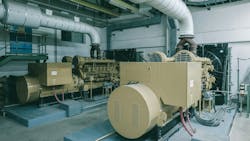Most facilities are aware of the electrical disturbances that occur on the electric utility side of the meter, as they are the recipients of these events. Voltage transients are caused by electric utility capacitors switching on or off, reclosers testing in and out, and foreign objects briefly brushing the power lines. These transients are typically accounted for and protected against with equipment having built-in surge protection or an uninterruptible power supply (UPS) with surge protection features. However, there is one transient event that is overlooked and may have been forgotten as the maintenance personnel at a facility changes over the course of the facility’s existence.
The automatic transfer switch (ATS) is part of a last resort system that comes into play when a facility succumbs to a voltage disturbance long enough to trigger the standby power equipment. The objective of this system is to transfer load from the electric utility system to a backup generator. Some facilities only back up selected equipment, such as critical loads that require a shutdown procedure, while others only connect emergency equipment that needs to remain on for the duration of the interruption. Other facilities use the backup generator to sustain most, if not all, of the facility until the electric utility system comes back online. Examples of these types of facilities include hospitals or hotels where patients and customers can have an adverse experience when power is not available. However a facility configures its backup topology, the ATS can create a large transient voltage during the switching process when inductive currents are disrupted. Any electronic load that is not connected behind a surge protection device will be directly subjected to this transient voltage. This can ultimately damage or reduce the life of electronic devices.
Most electronics have protective features built in, but they may be inadequate. Consider an additional layer of protection such as a UPS device with surge protection features, or an independent surge protector. Also, when switching over to an emergency configuration, find out if the independent surge protector switched with it to protect the emergency loads, or if the emergency loads no longer behind any type of layered protection. In the past, an ATS switching from an electric utility feed over to a backup generation source only caused incandescent bulbs to flicker and equipment to reset with minimal damage. However, that is not the case today, as more sensitive electronics-based LED light sources are being installed.
